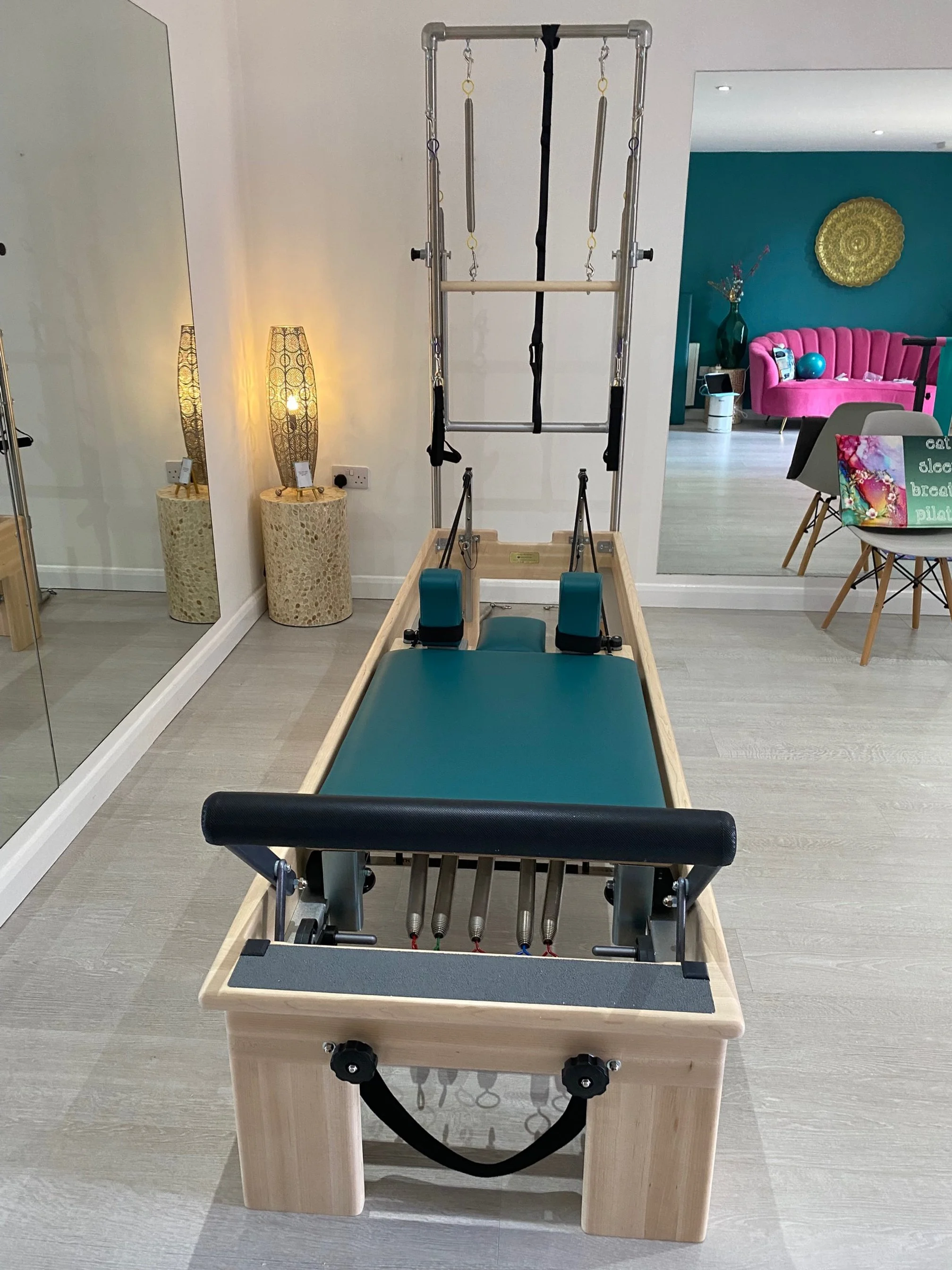Delving into the workings of a Reformer…
Reformers come in either a wooden or metal frame. At Mypilatesflow the frame is made of wood and is the Studio Reformer manufactured by Balanced Body in the US.
The basic fundamental shape, height and length of Reformers are pretty much the same although price does vary due to the quality of manufacturing.
Carriage
The Carriage is the main moveable part of the Reformer that glides back and forth against the resistance of the springs and is unique to the Pilates method of conditioning. The carriage which has between 4-8 wheels is placed on the runners to allow the carriage to slide smoothly back and forth and is padded for comfort. It comes with two shoulder rests and a head rest both are usually fully adjustable to suit a range of clients.
Foot bar
The Footbar has between 2-4 adjustable positions- high, middle, low and flat. The footbar will be moved to execute different exercises. For example a higher footbar will be needed for weight bearing exercises through the shoulder and wrist joints to support the upper body. Or a lower footbar will be needed to decrease the difficulty for exercises . Some exercises such as ‘Standing Leg Series’ will require the foot bar to be flat as well as some ‘Box series’ exercises.
Clients who are taller may need a lower footbar to decrease the angle in the hip, knee and ankle joints.
Clients who are recovering from hip, knee or ankle injuries may require a middle foot bar setting to reduce the pressure or range of movement within the joint.
Springs
Most Reformers are now manufactured with 5 Springs with various colours of resistance:
Blue- Resistance (x1)
Red- Endurance Training (x3)
Green- Strength (x1)
The springs are attached to the carriage to add resistance to the workout. The load on the spring should only be as heavy as the client can control maintaining technique and form in a flowing manner. To the on looker the exercise should look to be performed with ease!
Standing Shelf
The standing shelf is the ledge at the end of the Reformer. Standing and kneeling exercises are performed on the grippy surface.
Straps, Loops and Handles
Straps are made in either leather or strong nylon with loop or handle attachments for exercises that require the use of arms and legs. The straps are always of equal length. They are attached to the ropes which thread through the pulley system from the risers (the opposite end of the Reformer from the headrest) to the gate system or teeth system. This secures the ropes and stops them from slipping when tension is added.
Risers
The Risers are used to adjust the height of the ropes. For most exercises the risers remain in the one position, high or high to the middle. The lower the risers the more core stability is required for exercises such as the ‘Feet in Straps’ series.
Gear
The spring tension can be increased or decreased by either moving the stop, gear or footbar. The gear position closest to the footbar (1st position) will provide the greatest amount of resistance to the carriage.
The ‘Stop’
Some Reformers come with an adjustable ‘Stop’ which is inserted at the side of the Reformer runner to literally ‘Stop’ the carriage from returning to the ‘home’ position. The ‘Stop’ can be part of the gear placement. For example as the gear is moved away from’home’ though the positions, the stop can be adjusted for clients who require a decreased range of hip, knee or ankle movement due to injury or pathology.
Shoulder and Head Rest
The headrest is positioned between the two shoulder rests on the carriage and is usually adjustable- high, middle and flat. Some exercises will require the head rest to be fully flat due to the increase in pressure on the cervical spine.
Non Slip Mats and Grippy Socks
Non slip mats are added to the carriage to increase the safety for certain exercises and for hygiene purposes. Socks are worn that grip the Reformer surface.





